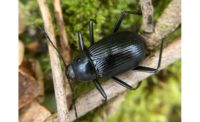McCloud Services’ 2019 Pest Invasion focuses on how to develop a successful integrated pest management program

McCloud Services, a leading pest management company headquartered in South Elgin, Ill., hosted its annual Pest Invasion premier food industry pest management seminar on June 27, 2019 at the Oak Brook Hilton Conference Center in Oak Brook, Ill. The seminar was attended by more than 150 pest management, environmental health, and food safety professionals, and featured a variety of top speakers. This year’s agenda was designed to include all the elements required in building and maintaining a successful integrated pest management (IPM) program. As one of the few pest management seminars with a focus entirely on the food industry, McCloud Services announced some key takeaways from the event.
The central theme of Pest Invasion 2019 revolved around food safety and developing and auditing an IPM program. Industry experts presented information on building an IPM program as well as auditing and measuring the program’s results. Speakers also shared the pest threats food facilities are most likely to encounter along with inspection and exclusion tips. At the end of the seminar, attendees learned about the newest pest control technologies in order to more efficiently manage pests throughout their facilities.
Invited speakers included: Scott Broaddus of Bayer Digital Pest Management; Dan Collins, BCE of McCloud Services; Dr. Bobby Corrigan of RMC Pest Management Consulting; Patricia Hottel, BCE of McCloud Services; Meaghan Meyer of CraftMark Bakery; Peter Poteres of Glanbia Performance Nutrition; Al StCyr of ASC Consulting; and Mark Vanderwerp of Rose Pest Solutions.
Key takeaways from the conference include:
- Program Design: What a Winning IPM Program Looks Like by Peter Poteres
Poteres presented information on how Glanbia Performance Nutrition renovated existing plants and designed new facilities with pest management in mind. At one facility, the company redesigned their water up system to reduce water waste, which in turn reduces pest activity. Glanbia installed a closed cleaning system with newly constructed docks, including an internal dock, to reduce the amount of water waste and the potential for pest survival. This system eliminated nearly 90% of the water used on site for cleaning operations.
While this problem was solved, Poteres explained the importance of researching other ways pests may enter facilities. For example, one of the biggest pest pressures for Glanbia is its location and proximity of train rails to its property. Poteres recommended attendees develop relationships with neighboring properties to understand the impact neighbors can have on certain pest pressures. This allows for the development of appropriate monitoring and exclusion programming, such as exterior rodent devices and a stronger pest-proofing program overall.
Click Here to Download the Presentation
- Don’t Let Them In: Pest Proofing and Exclusion Methods by Dr. Bobby Corrigan:
Dr. Corrigan explained why workmanship in pest proofing is critical. From poorly installed concrete to sewer systems to subway station garbage rooms, rodents and other pests find a way to enter structures. While it is difficult and expensive to renovate or fix these weak structures, like New York City spending $5 million to rodent proof the garbage rooms in order to solve the rodent infestation, the cheaper alternatives may not always be the best option.
While many believe expanding foams can be used as sealants, this system is anti-food safety. The foam adds to heat retention, which could increase pest survival in addition to the lack of cleanability. It also allows pests to gnaw and chew through it as it becomes brittle overtime.
Dr. Corrigan finished his presentation with the “Big Four” pest proofing needs:
- Thresholds of doors
- Penetration around pipes and utility lines
- Holes and crevices in walls, and
- Holes and crevices in floors.
He then went into depth on the need to inspect for rodent trails and other parts of the facility, including wall voids, ceilings, roofs, etc. Dr. Corrigan reiterated the importance for proper sealing materials in these areas so rodents cannot chew through them and enter facilities. He advised to get ahead of pest management issues by consulting with the builder and a pest management professional to take a proactive approach against pests.
- Find Them if They Make It In: Pest Control Inspections by Dan Collins
After developing an IPM program and finding ways to pest proof structures, Collins went into detail on how to inspect for pests after they enter a facility. He began his presentation by sharing insights on the top five challenging pest categories, which include rodents, stored product insects, small flies, cockroaches and occasional invaders.
He then went into the oftentimes overlooked areas that many pests enter facilities. These include roof tops, utility tunnels and racking systems. For roof tops, it is important to understand how the roof is constructed so that food safety managers can also know where pest access points are located. While utility tunnels can be difficult and dangerous to inspect, it is critical they are inspected as the tunnels are a major pest access. Finally, inspecting racking systems for signs of pests is also crucial as it is oftentimes the root cause of a rodent infestation. Facility managers should be sure to check this area for sebum.
Collins closed his presentation with his top three pest management tips:
- The easiest way to introduce a pest to your facility is transferring product or material from facility to facility.
- A stationary compactor should never be used for food. These systems are only meant for corrugated material.
- Use the BUGO trap from JT Eaton around equipment legs in facilities for pest monitoring. Although the trap is designed for bed bugs, it works for other commercial pests as well.
Click Here to Download the Presentation
- Kill Them: The 5 Biggest Pest Threats by Mark Vanderwerp
Attendees learned the five biggest pest threats from Vanderwerp. These include flies, birds, stored product pests, cockroaches and occasional invaders. He went into depth on the inspection tips for these pests along with the best elimination methods.
- Birds
When it comes to birds, Vanderwerp explained the three most common types to watch for: House sparrow, European Starling and pigeons. These birds often cause damage to buildings and can also contaminate products. To eliminate birds, he suggests trapping, baiting or placing scare devices, and aggressive harvesting.
- Stored Product Pests
Due to their size and ability to stay hidden, stored product pests are difficult to eliminate. While fogging or ULV treatments are seen as a treatment method, they should not be a “go to” elimination solution. Although the first treatment may be successful, it will ultimately become less and less successful over time. Instead, Vanderwerp advised attendees to check tough to clean areas and sanitize them, while also using pest pheromone traps as a monitoring tool. However, it’s important to note that these pheromone traps are just an early warning system and they won’t control the infestation.
- Files
Flies are a common pest in food facilities. There are four types: biting flies, small flies, filth flies and seasonal invading flies. The first step to eliminating flies is identifying potential entrances, such as drains, in the facility. If maggots are discovered, immediately remove the media they are in and bring them outside. Vanderwerp cautioned how important it is to ensure external entrances are closed in order to keep adult flies out and prevent food product from becoming contaminated.
- Cockroaches
Cockroaches can present a big challenge when trying to handle an infestation. Oftentimes, this pest will hide in tight spots such as sewers, walls or behind machines. Due to this, Vanderwerp shared the importance of monitoring devices so food facilities can isolate equipment and deliveries. In addition to monitoring devices, a wide variety of other control techniques must be used, including good baiting techniques that only use the proper amount of bait.
- Occasional invaders
Occasional invaders, organisms from the surrounding area of the facility, may enter the structure intentionally or accidentally. These pests don’t reproduce and barely eat, but are still a nuisance in food facilities. It is important to be aware of the environment around the structure as occasional invaders are attracted to various landscape items. When controlling these pests, be sure to seal and exclude exterior entrances, be aware of exterior lighting due to occasional invaders’ attraction to it and consider perimeter barrier treatments.
Click Here to Download the Presentation
- Winning the Challenges & Measuring Results by Meaghan Meyer, Al StCyr and Dan Collins
Meyer, StCyr and Collins presented on how to measure results of an IPM program. First, the group went into detail on how it is the food manufacturer’s responsibility for an effective pest management program that effectively prevents food adulteration while it is the pest management professional’s (PMP) responsibility to protect the food product integrity. Due to this, the facility should be well versed in the pest control program and understand basic entomology. There should also be a collaborative relationship with the PMP to ensure complete product protection.
The group shared that once an IPM program is implemented into a facility, it is crucial to examine the results. The auditor’s role in pest management is to assess the results of the established program’s development and specifics. They noted the importance of providing a detailed Scope of Service that outlines precisely how the pest management work will be conducted to ensure it complies with federal and state regulations. The program should also include an established method and expectations for communication between the PMP and facility.
Click Here to Download the Presentation
- Innovate: Introducing New Technology by Pat Hottel and Scott Broaddus
Hottel and Broaddus discussed new technologies that have been, or are in the process of testing at McCloud as well as some systems that have already been incorporated in permanent installations. In fact, the company is currently testing six different remote rodent monitoring systems and is planning to test insect remote monitoring in the future.
From the group’s research, they have found that one of the greatest advantages of the remote rodent monitoring systems is the potential to integrate beyond rodent captures alone. Some of the newer systems have the ability to measure temperature, humidity and open doors, in addition to the capture of pests in the monitors. Even though these devices are designed for rodents, some of the system’s capabilities are more relevant to insect pests.
Hotel and Broaddus believe that with these systems, pest management will greatly improve. PMPs’ will be able to determine the root causes and solutions in the prevention and control of pests, dramatically changing the understanding of pests and their behaviors in facilities. This will inevitably yield more successful programs and pest prevention for the future.
Click Here to Download the Presentation
For more information visit: www.mccloudservices.com.
Looking for a reprint of this article?
From high-res PDFs to custom plaques, order your copy today!





